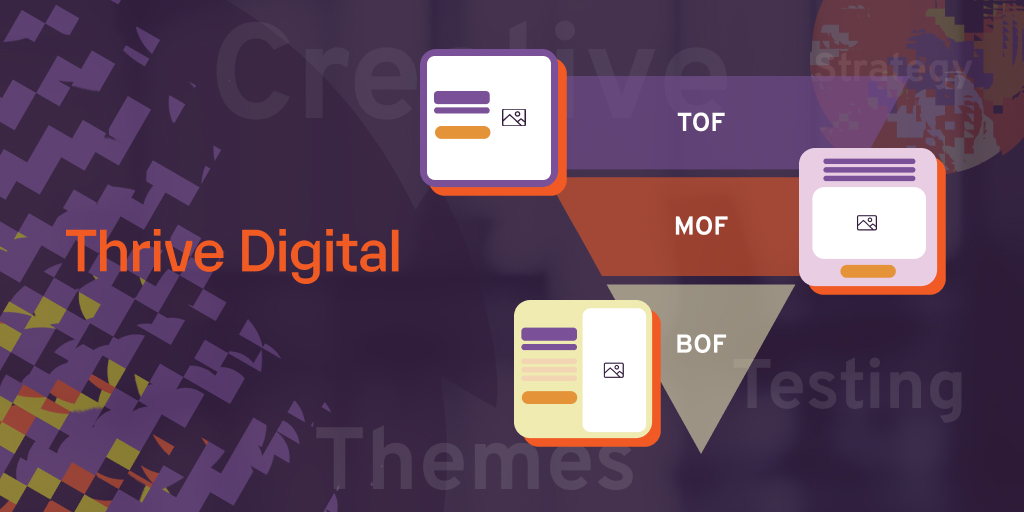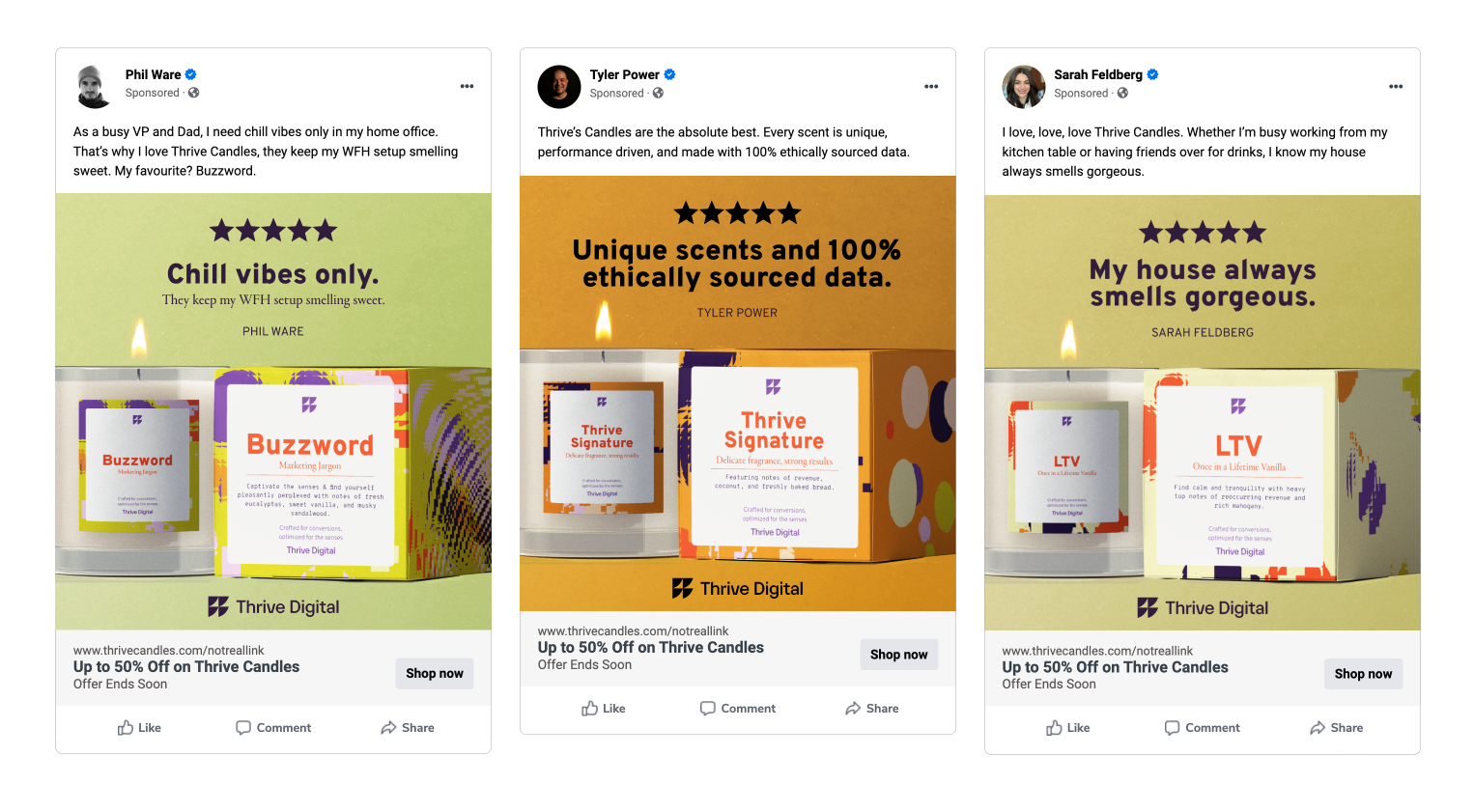
TL;DR in this challenging e-commerce landscape, creative inventiveness can beat out (or overcome) traditional, digital approaches. We recommend exploring different creative ad themes, creating assets and messaging specific to the part of the funnel the audience is in, and getting specific in how you craft static images, videos, and UGC. This is one of those articles that it's better to bookmark for reference and dive into each section rather than skim so we've added a clickable table of contents on this one.
The year is 2023. The cookie is on its way out the door, your competitors have all the same tools and information as you, and short of going absolutely rogue on social media a la Duolingo (we don’t offer organic social media services and as such we can’t endorse doing this), it’s a tough market for an e-commerce business to stand out in.
So how is a good brand supposed to stand out and convert? The answer is creative. Creative is at the forefront of every successful non-search campaign. Aside from product, it’s one of the very few differentiating factors you have.
That’s why in this blog we’re going to break down the factors that go into high-conversion e-commerce ad creative. Here are the categories we’ll touch on (go ahead and click them to jump right to the section):
Landing page vs. web page (why they are, and should be, different)
What is ad creative?
Ok, this may seem a bit introductory but it’s important to clarify what we’re actually talking about here. Digital ad creative represents the creative imagery, messaging, video, and all other creative elements within a digital ad. Digital ads are normally part of a broader ad campaign, wherein different ads are used in conjunction with a specific message,CTA, event, incentive, or promotion being highlighted. These can take place across multiple platforms (think Meta, Google, TikTok, etc.) and multiple mediums (video, static images, text ads, etc.).
Creative themes
Before even diving into creative mediums, let’s talk about common creative themes that we can test and play around with. There are many different types but there are eight common themes we come back to time and time again.
To illustrate, let’s use our very popular, 100% fictional Thrive Candles™ as an example.
Feature & benefits
This theme includes features of the product (made with locally sourced essential oils), the value of the product or why it’s helpful (fills your whole home with a gorgeous scent), and how it can save the consumer money/time/effort
Pain points
This theme centers around easing pain points your audience has. For example, our Thrive Candles come in quarterly subscription packages so you never forget to restock your favorite candles. The pain point we would address in creative could be someone’s favorite candle running out right before they host a dinner.
User Generated Content (UGC)
This is exactly what it sounds like, any favorable content created by your direct customers. This includes real use cases, product shots,unboxing, product reviews, top tips, mashups and lots of other types of scenarios using your product or services. The difference between this and influencer content is that it feels more authentic, adds more credibility, and shows value more organically.
Testimonials & social proof
Customer feedback and reviews provide real feedback from real users to show your audience what existing customers think of your product. Some ways to incorporate this are by sourcing from review sites or direct customer feedback like emails, ratings or social comments. Another big benefit here for your audience is they feel like they’re mitigating risk by getting endorsement from real customers they can relate to.
Earned media mentions
Anytime publications mention your brand in a positive light, it’s a great opportunity for creative content. This theme is akin to testimonials and can be used in a similar fashion.
Brand
Brand creative and content is all about sharing who you are, your values, your position, educating users on why to choose you, and what your brand is all about (The more robust brand story). This is less campaign or offer specific and revolves more around creating general brand awareness among your audience.
Offers
Sales, discounts, events like Black Friday/Cyber Monday, Mother’s day, national siblings day, and other special offers are other often used themes in e-commerce and B2C or D2C brand creative. This particular theme creates a strong incentive to purchase and instills a sense of cost-benefit.
Now that we understand what some common creative themes are, let’s talk how each of those themes can play into the different stages of the funnel.
Understanding creative by funnel stage
Designing creative for ad campaigns is different from broader brand projects. One of the most important functions is understanding the consumer journey and how ads should be adjusted based on where the user is within the buyer lifecycle (or funnel). At the very least the messaging needs to be adapted to suit the user journey.
Here are some of the considerations we make with top of funnel (or ToF) creative:
- What is the product or brand
- Why it’s helpful (Unique Selling Points or USP’s)
- Why I should stop to watch/view this product or brand
- Who needs this product (self or gift)
Mid funnel and bottom of funnel (MoF and BoF) have their own set of concerns to address including:
- Why buy this product
- Why this product or brand is better than competitors (benefits)
- What would motivate me to buy your product or service
- What would deter me from buying your product or service
- What pain-points will this product solve (value proposition)
- FOMO: instill regret of not getting it
- Customer reviews (does it work?)
.png?width=932&height=524&name=Screenshot%202023-11-27%20at%204.32.55%20PM%20(1).png)
Using creative themes with each funnel stage
Creative themes can be a powerful tool when selected based upon where a consumer is at in the customer journey (or funnel stage).
Based on how product or solution-aware a user is, there are different types of creative themes that can have the biggest impact in pushing through a conversion. For example, showing someone an ad talking about how customers love using your brand, when your audience doesn’t even know what your brand is, won’t have a positive impact on down-funnel conversions.
Strategically implementing different creatives across an account is extremely important.

Creative testing
Creative is at the forefront of every successful (non-search) campaign.
With constantly changing customer preferences and trends, creative testing is vital to ensure your ads continue to resonate with your target audience.
Here are the 3 reasons why creative testing is important.
Maximize scale & growth
Identify new creative themes to unlock incremental reach and revenue
Gain messaging insights
Understand the best way to message and promote a specific product
Maximize efficiency
Attain creative learnings to improve efficiency across current and future creative concepts
Types of creative tests
When looking at creative testing, the first thing you should ask yourself is what is the outcome you’re looking for. To ensure results are clean and you achieve the best learnings, it's important to not test multiple variables at once.
Determining whether you need to test creative direction (imagery & visuals), copy direction or ad placement and tactics (format) is crucial to the success of any test.
Thematic creative testing
When looking at creative testing, one other area that can be valuable to focus on is larger creative themes rather than micro creative elements to achieve impactful long term growth.
A word of caution on creative testing
When testing creatives, it’s not as easy as just dumping the new creatives into all your old campaigns and sitting back to find out how they did.
- Multiple variants can make it difficult to have full confidence in results
- New ads can struggle to spend/achieve scale
- Learnings will be slower with the thematic approach and it can be difficult to gain conclusive results.
- Full credit for a conversion is given to only one creative, which can lead to cross contamination.
The long term success of creative testing, depends as much on the way the test is structured as the creative itself.
Static image ads
Static image ads are just that, ads that are just photos with no video component. These ads are still a staple, even in an increasingly video-first social environment. Here are some of our recommendations on things to include and consider when building out these types of ads.
- Keep your brand top of mind and be sure to match the look and feel of your brand (including your site)
- Be sure to use a strong, focused headline or hook (what is the ask or story you’re telling?)
- Pair your hook with a USP to solve a pain pointpainpont
- Add a clear, compelling CTA (this should be indicative of where they will be landing and what they will be expected to do)
- Use high-quality photography
Get platform specific
- Use the correct aspect ratios for the platform and ad format, e.g. All Meta ads should include 1:1 & 9:16
- Leave safe space for Native UI features, e.g. Meta CTA’s on stories
Also note, static images can be leveraged and repurposed cross platform and within a single platform.

User Generated Content (UGC)
First of all, what is UGC and why is it important for e-commerce? UGC is any brand related content created by your customers or audience. This includes real use cases, product shots, and lots of other types of scenarios using your product. UCG is important because it offers social proof other customers love and get value from your products. As platforms like TikTok grow and other platforms try to keep up e.g. Meta Reels, and Youtube Shorts, UGC content is going to continue to grow as a large part of all e-commerce brands creative strategy.
- Consumers are 2.4 times more likely to view UGC as authentic and engage with it compared to content created with traditional photoshoots.
- 55% of consumers trust UGC over any other form of marketing, making it a way to boost your sales and improve brand loyalty.
- 51% of millenials say that UGC from strangers is more likely to influence their purchase decisions than recommendations from friends, family or colleagues
Top ways to generate UGC
- From your customers
- From influencers (white labeling)
- From hiring real people, friends, family, employees of brand
Video ads
Video ads are exactly what they sound like and can showcase any of the creative themes we listed above. Designing video ads can be a bit of a heavier creative lift, but has a big pay off. \
Types of content footage
What kind of footage should you be shooting when you create video content? The choices are nearly infinite but we’ve found a lot of success in these three categories when creating video content for our e-commerce clients.
1) Product shotsUnboxing, product close ups, pans and flat lays
- Showcase the experience of receiving the product
- Using the product
- Product feature benefits and tech specs
- Highlight the aesthetic of the packaging
- ASMR when applicable
Product demo, lifestyle
- How to use product
- How it fits into your customers life
- How it answers a lot of those faqs (anticipate the questions)
- Shoot different angles and POV’s
Selfie mode, talking + head with product, green screen effect (tiktok)
- Helps puts a real face to the ad
- Multiple angles (second cam if possible)
- UI/UX walk throughs and in-app demos
- Helps build credibility
Tips for creating effective video ads
Google conducted a meta-analysis of thousands of ads and came up with a useful A, B, C, D framework to consider when designing your video ads.
A Attract
- Use tight framing on the subject
- Aim for 2-3 shots in the first 5 seconds
- If people appear in your video, open with them on-screen
- Use stunning, eye-catching or otherwise memorable imagery
B Brand
- Introduce your brand or product in the first 3 seconds
- Optimize logo placement for your marketing objective (brand persistence = recall)
- Show visuals (mascots, colors) unique to your brand
- Use on-screen actors for brand audio mentions
C Connect
- Treat function and emotion as levers that can work together or independently
- Don’t shy away from functional storytelling
- Lean into emotional levers like action, humor, and intrigue when it works for your brand
- Make people core to the story
D Direct
- Show offers and call-to-action through text cards, simple animation or voiceover
- Make offers inspire a sense of urgency
- Use specific CTAs (e.g., Visit site, Sign up, Buy now, Explore, Discover our story) or include a search bar
Landing page vs. web pages
Something that we’ve seen time and time again is a confusion between landing pages and web pages. This is important to note because a landing page is where your ads (of any variety) will take the viewer. So what is a landing page and how is it different from a web page? A landing page is a web page designed to persuade users to take one specific action. For example, having users sign up for a newsletter, purchase a product, or RSVP for an event.
The key difference between a homepage and a landing page is focus. As opposed to web pages, which are designed for exploration, landing pages are customized to a specific campaign or offer and guide visitors towards a single call to action. In short, landing pages are designed for conversion.
To put it in a quick, digestible way:
Landing pages convert. Web pages inform.
Good creative pays dividends
Making your ad spend as efficient as possible comes from many factors, but effective creative is high up on that list. One last tip we’ll leave you with is not to ignore past performance. You probably don’t need to start from scratch once you have some good creative campaigns under your belt. Within your digital asset management and libraries likely already live a ton of useable creative. It always helps to analyze this creative, developing insights and hypotheses around historical performance. Sometimes the answer's already there. Current asset optimizations are low-hanging fruit and can bide you some time while you refresh your creative with net new concepts and themes.
 Tyler Power
Tyler Power